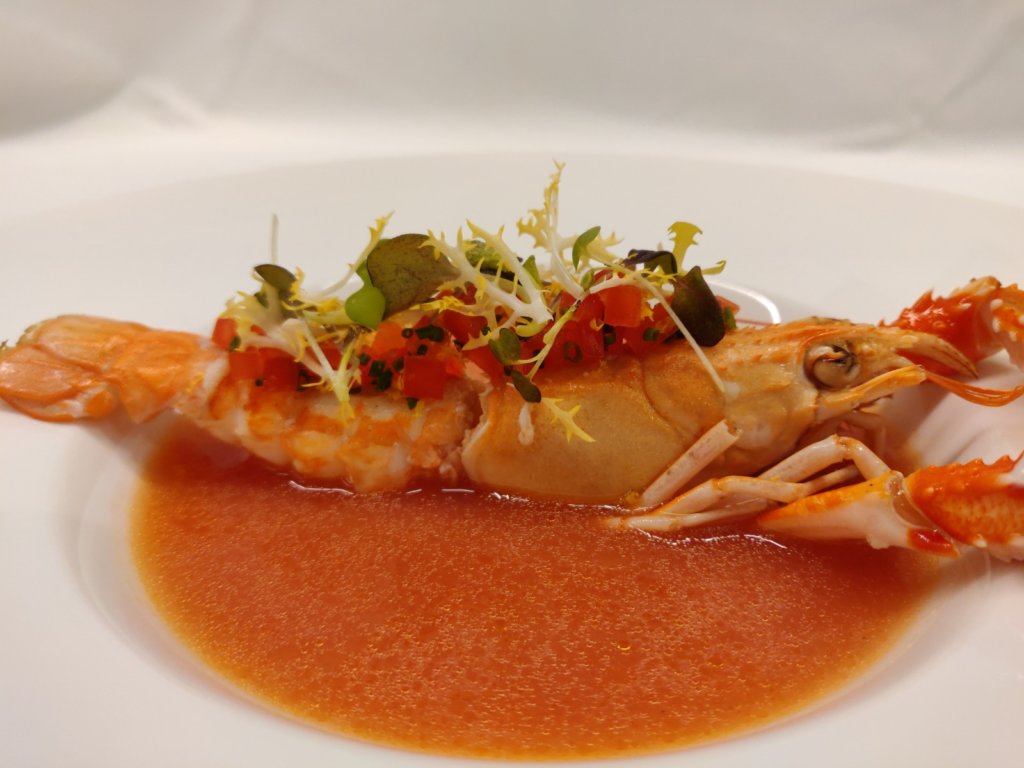Clearwater Kitchen » Recipes » Norway Lobster Recipes » Whole Norway Lobster Recipes » Roasted Langoustine in Blood Orange Bisque

Serves 4 as an appetizer
4 whole 200 g Langoustine, Whole, 5-12 Count
1 tbsp 15 g Olive Oil, Extra Virgin
To Taste Salt
To Taste Black Pepper, Ground
¼ lb 114 g Langoustine, Heads and Shells
3 tbsp 45 g Olive Oil, Extra Virgin
½ head 30 g Shallots, Sliced
1/8 30 g Fennel, Sliced
½ leaf 0.12 g Bay Leaf
¼ tsp 0.25 g Black Peppercorn
½ cup 125 g White Wine
½ cup 125 g Water
½ cup 125 g Blood Orange Juice
½ cup 125 g Canned Tomato, Diced in Juice
¼ cup 37.5 g White Rice, Cooked
1 tbsp 15 g Double Cream, 35% (optional)
To Taste Salt
2 tbsp 25 g Tomato, Roma, Concassed
1 tsp 5 g Olive Oil, Extra Virgin
To Taste Salt
Garnish Blood Orange Zest
Garnish Microgreens, Amaranth
Garnish Fennel Fronds
Defrost Whole Langoustines in the refrigerator overnight or a minimum of 8 hours until there are no ice crystals on the exterior of the product.
Using kitchen shears, trim around the tail flaps and the head to remove the shell on the langoustine tail. This will reveal the flesh of the tail while still being attached to the head and tail flaps. Using a toothpick, gently remove the intestinal tract from the tail.
Brush the whole langoustines with olive oil and season with salt and pepper. Roast in a pre-heated oven at 190οC for 8 minutes or until internal temperature of the langoustine head reaches 73οC.
In a pot on medium heat, sauté langoustine heads and shells with olive oil, shallots, fennel, bay leaf and black peppercorn until fragrant and the langoustine shells soften a little. Decant into a food processor and process until it becomes a paste.
Return the paste to the pot and sauté on medium high heat until the paste starts turning slightly golden and dry. Add white wine, then stir and simmer on medium heat until white wine reduces by half. Add in water, blood orange juice and canned tomatoes, then purée with a stick blender until smooth. Add in cooked white rice and bring the bisque up to a boil on medium high heat. Reduce heat to medium low and simmer until the rice releases enough starch to thicken the bisque (approximately 20 minutes). Strain the bisque through a mesh strainer to remove any undissolved rice and stray bits of shell. Optionally, stir in double cream for a creamier texture. Season before serving.
In a small mixing bowl, toss together concassed tomato, olive oil and season as a garnish.
To plate: In a bowl, place the whole roasted langoustine, then fill around with the blood orange bisque. Garnish the back of the langoustine with the seasoned tomato mixture, blood orange zest, microgreens and fennel fronds.
To serve our customers better, our website content has been customized for different customer types based on their needs and interests. Have a suggestion on how we can serve you better, please let us know.
